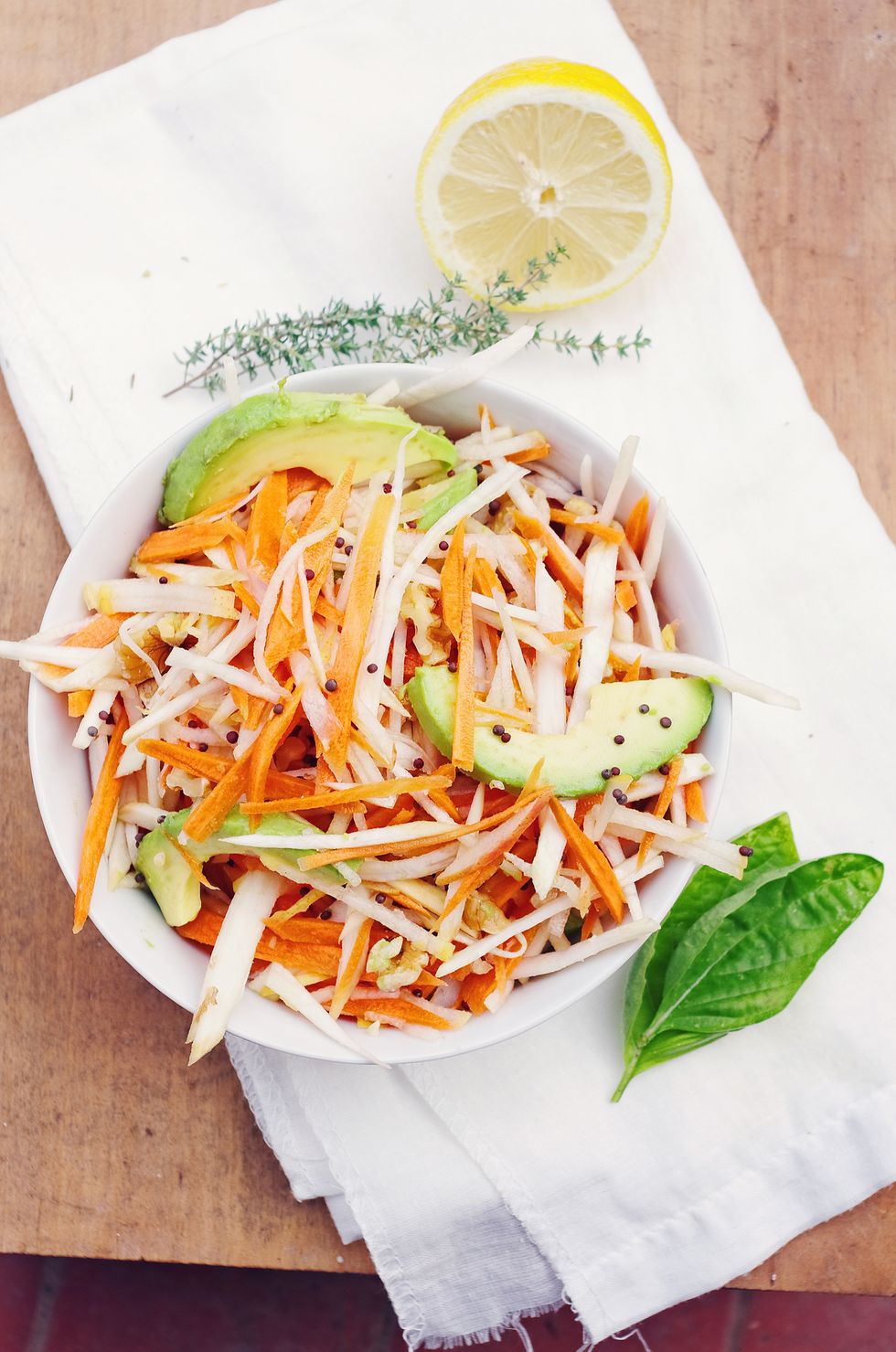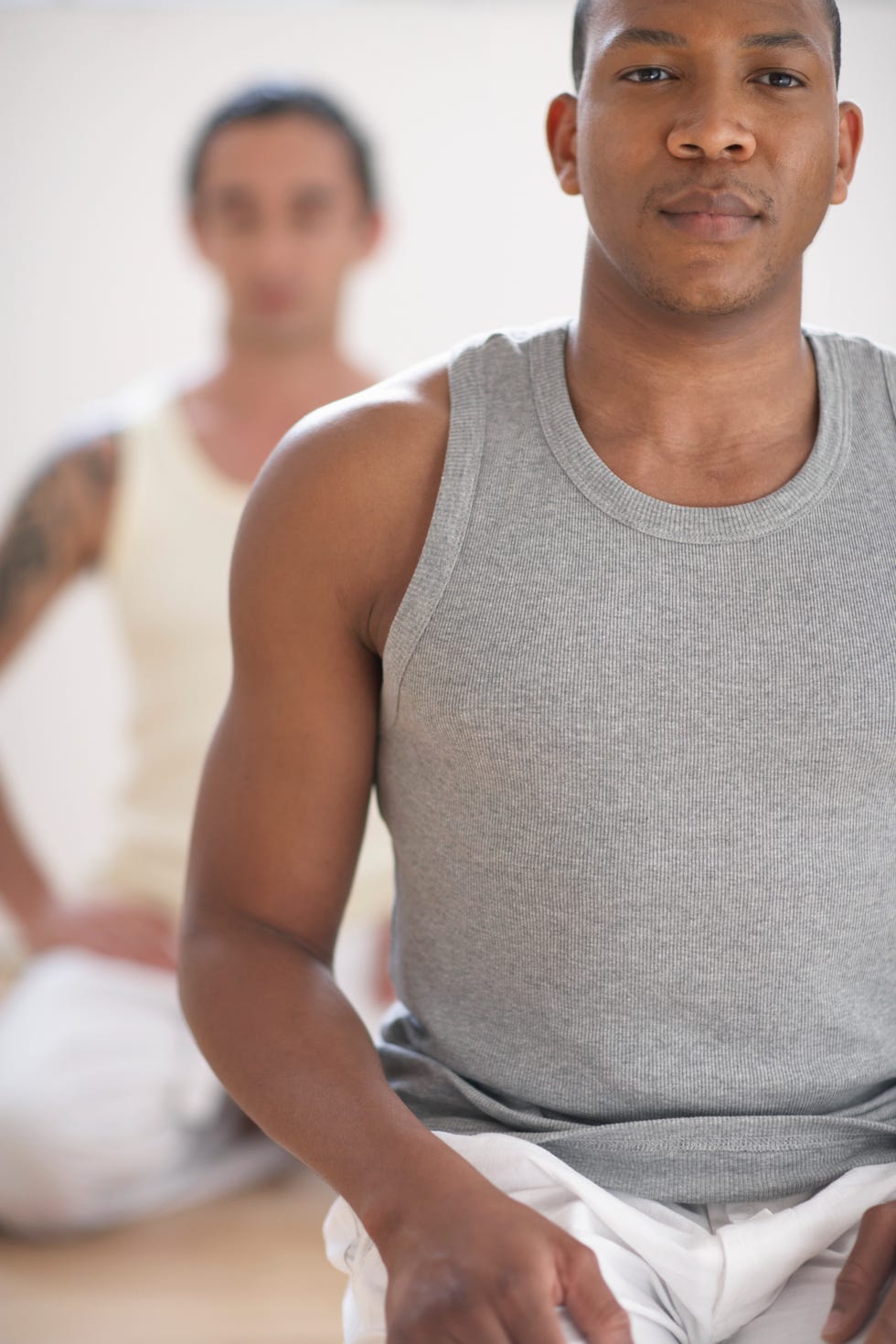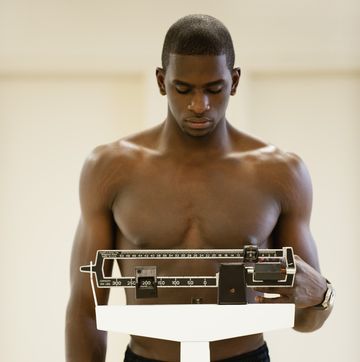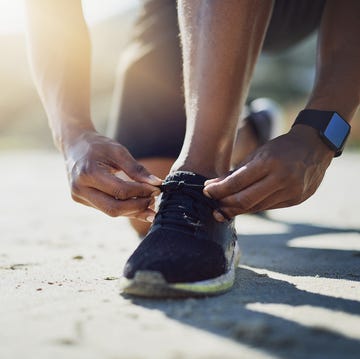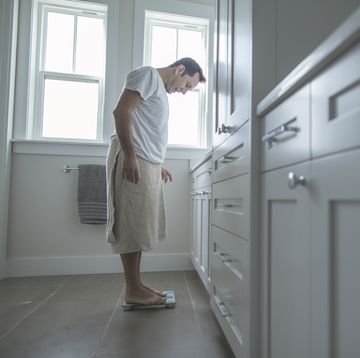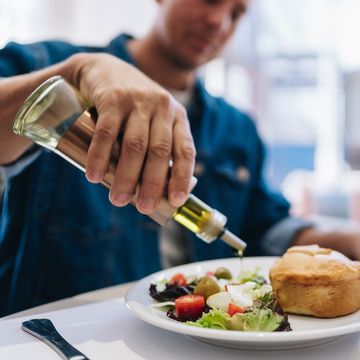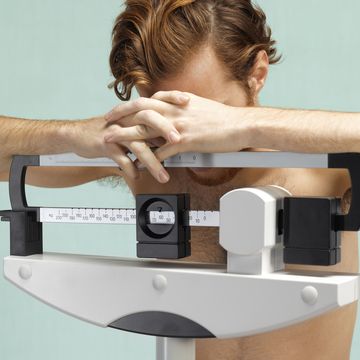THERE'S NO IDEAL time to begin a weight loss journey. Weight loss might be more difficult the older you get, but that doesn't mean it's not worth the effort. Losing weight after 50 is tough—but certainly not impossible.
There are always benefits to maintaining a healthy weight, regardless of age. Decreasing your body fat and increasing your muscle mass will help improve daily functioning, decrease blood pressure, reduce the risk of diabetes, cancer, and other diseases, improve energy levels, improve mood, and boost confidence. Losing weight isn't an easy process, regardless of age—but attempting to lose fat later in life may present a few extra challenges.
One factor that may inhibit the ability to quickly shed pounds is the effect of aging on our metabolism. It begins to slow down as we get older, says Kate Ingram, M.P.H., R.D.. Our muscle mass deteriorates overtime—a natural process known as sarcopenia. It lowers about 3 to 8 percent per decade, according to the National Library of Medicine. Our muscles require more energy, and more calories, to survive. When that muscle mass starts to diminish, our bodies, in turn, burn less calories overall. “It can be harder to create the calorie deficit necessary for weight loss."
Plus, hormonal changes can affect appetite and fat distribution, often favoring abdominal fat gain. As Ingram says, reduced physical activity, changes in dietary habits, and the potential for emotional factors like stress or emotional eating can also contribute to weight gain. Health conditions and medications may cause complications, too.
Plus, life gets in the way sometimes. “Between work obligations, family life, and responsibilities, commute time sitting in the car, etc. there isn't as much free time left for exercise and physical activity,” says Lauren Zimmerman, M.S., R.D.
That doesn’t mean it’s impossible to get the ball rolling on weight loss when you're older. With a balanced diet, regular exercise, proper medical guidance, and a patient, sustainable approach, weight loss is still possible and beneficial after the age of 50, says Ingram. Keep reading for dietitians’ top 22 strategies to lose weight in your fifties—and beyond.
1. Eat More Fruits and Vegetables
To lose weight, one approach is to take in fewer calories than you expend. Instead of focusing on what to eat less of, let’s talk about what to eat more of. First up, fruits and vegetables. In a study from Harvard, people who increased their intake of fruits and vegetables lost weight, especially if they ate more berries, apples, pears, soy, or cauliflower. Fruits and vegetables are low in calories but rich in important vitamins and minerals that you need more of as you age, including fiber, which can keep you full between meals, says Katherine L. Tucker, Ph.D., professor of nutritional epidemiology and director of the Center for Population Health at the University of Massachusetts-Lowell.
She recommends piling vegetables over half your plate at every meal. Keep frozen vegetables in your freezer so you never run out (here's the best way to freeze extra veggies yourself), and get creative with your salads by adding olives, cheese, or sliced oranges to make them more interesting. Check out our favorite breakfast salads—yes, breakfast salads—for more inspiration (sweet potato, spinach, and an egg is definitely breakfast!). Holly F. Lofton, M.D., director of the Medical Weight Management Program at NYU Langone Health, recommends "easy" vegetables: "Try ones you can just wash, cook, and eat, like asparagus and broccoli," she says. Of course, you don't even have to cook baby carrots.
A few easy ways to sneak veggies into your diet: Add some spinach, carrots, beets, or squash to smoothies. Blend some up to add to spaghetti sauces or soups. Take some veggie chips and use them as a dip for hummus or salsa (which are also veggies!).
2. Use Beans as a Base
Beans are packed with filling fiber and protein, and as they travel through your digestive system, their roughage and resistant starch feeds the good bacteria in your gut, says Tucker. These bacteria in turn create short-chain fatty acids, which are helpful in protecting your metabolism. A study review from Canada shows that people who ate a serving of legumes every day as part of a weight-loss effort lost a couple of pounds in an average of six weeks. Try making beans or lentils in an Instant Pot, which allows you to stew legumes with vegetables and other flavorful components and make enough for the whole family. You can even puree them to add to soups, stews, and even mac and cheese without changing the flavor or texture that much. Expand your repertoire by trying new types of beans—discover your healthiest choices here.
3. Befriend Your Bathroom Scale
Weigh yourself each morning so you notice right away if the number is trending up instead of down. “If you gain weight, and if you focus on it early and it’s only a few pounds, you can lose it quickly, but if you let it stay, basically it reprograms your body at a higher weight and it makes it hard to lose because you get hungry,” Tucker says. If you want to lose weight over 50, it's especially useful to jump on any gain right away.
4. Or, Ditch the Scale
That doesn't mean weighing yourself daily or weekly is for everyone.
“As we age, metabolism tends to decrease, muscle mass may decline, and hormonal fluctuations can impact weight distribution,” says Marine Melamed, R.D.. It's normal to experience some weight fluctuations. “Accepting these changes is the first step towards achieving realistic weight loss goals.”
For this reason, instead of focusing on the number on the scale, consider how energized you feel throughout the day, the healthy food choices you make, how your clothing feels like it fits, your body composition, and body measurements. According to Melamed, those parameters can help you evaluate your progress in a healthier and more positive way if you’re the kind of person that places a ton of pressure on the number on the scale.
5. Focus on Your Food
Between 15 conference calls, appointments with your accountant, and all the other obligations facing the modern 50-something man, you might not be giving your meals the respect they deserve. “People on the go tend to overeat,” says Bettina Mittendorfer, Ph.D., a research associate professor of medicine at Washington University in St. Louis, but eating slowly and mindfully can help your weight-loss efforts.
Instead of shoveling in lunch between meetings, plate your food, take a seat, and chew slowly so that you enjoy each bite. Adding crunchy elements to your meal, such as sliced jicama or cabbage, can also help you slow down and eat less. It may also help to choose foods that require the use of utensils. One more thing: Use Netflix as an after-dinner treat. Eating in front of the TV is associated with weight gain, according to research published in the journal Obesity.
Traveling is another danger zone for mindless eating, especially if you're one of those people who eats when food is presented to you, says Dr. Lofton. She recommends that you carry with you something easy that you usually eat once a day—so pack your standard breakfast or something easy and nutritious for lunch. (See how one guy who drove 15,000 miles in 4 months stayed healthy.) "This creates some structure when you're in situations where you don't have as much control over meals," she says.
6. Track it, Too
Speaking of focusing on food, tracking what you eat might help you realize where exactly these spare calories are sneaking in.
“This can be done via a food tracking app,” Mary Wirtz, M.S., R.D., board certified sports dietitian, ticking off a few options such as My Fitness Pal, Calorie King, or Noom, “or even old-school paper and pencil.”
You can even snap a picture of eat to evaluate the look of your plate if tracking calories isn't for you. Why do it? The benefits of tracking your food intake are outstanding as, most often, this increases awareness around food choices, serving sizes, and mindless snacking and grazing. A large 2019 study showed individuals who kept daily food records lost twice as much weight as those who kept no records— might be worth a try.
7. Stop Drinking Sugar
Sugary foods and drinks fill you with calories—about 150 calories in a can of Pepsi, for example—but they don’t satisfy your appetite, which men over 50 undoubtedly have figured out by now.
“A soda goes down quickly,” says Mittendorfer. “Eat the equivalent in a salad, and you’ll stay full longer.” (You’d have to eat more kale than you can stomach to hit 150 calories.) Among the benefits: People who stop drinking soda and other sugar-sweetened beverages gain less weight over time than those who do, a study review from Australia suggests.
Even smoothies and juices can contribute lots of sugar to your body, Dr. Lofton points out. (Unless it's one of these healthy weight loss smoothies, but you still have to plan for them.) It's better to have the whole fruit than just the juice.
8. Mix Up Your Workouts
If you’ve been leaning on one type of exercise up to this point, now is the time to mix it up. In a recent study from the University of Illinois at Chicago and Iowa State University, older people who did a combination of 30 minutes of aerobic exercise and 30 minutes of resistance exercise three days per week reduced their body fat percentage and gained muscle. (They also showed improvements in blood pressure and cardiorespiratory fitness, which are important boosts to an aging heart.)
Resistance training is particularly effective in helping you build muscle, which burns more calories than fat, and aerobic training is particularly effective for helping you lose fat, says study author Elizabeth Schroeder, a doctoral candidate. “Together, they lead to a favorable body composition change and increasing strength and fitness with aging leads to a better quality of life and maintained independence,” she says.
For strength, “focus training on the legs and large muscle groups of the upper body with compound lifts, such as squats, deadlifts, bench presses, and pull-ups,” says Stephen Anton, Ph.D., associate professor and chief of the Division of Clinical Research at the University of Florida College of Medicine’s Department of Aging and Geriatric Research. “These lifts engage more muscle groups than isolated lifts and typically lead to a greater increase in muscle gains while stimulating fat metabolism.” (And check out our guide to resistance training for beginners.) For cardio, find something you enjoy, whether it’s running, cycling, swimming, or walking. Branch out and check out the best cardio workouts that aren’t running.
Even better than a steady-state cardio workout is interval training, which combines periods of intense work followed by periods of lighter activity. If it’s been a while since you worked out, consult a personal trainer to assess your mobility so you know where to start.
9. Discover a New Way to Eat
Here's a different way to think about how much you eat: Kristin Kirkpatrick, R.D.N., consultant for integrative and lifestyle medicine for the Cleveland Clinic, recommends this to her clients: Stop eating when you're no longer hungry. Not when you're "full." This could be a game changer. Learn more about it here.
10. Try Intermittent Fasting
Intermittent fasting might sound intense, but it just means that you eat methodically during a certain period of the day instead of eating whenever you want. That naturally limits the amount you eat, and some experts think no-food windows are good for your health, too.
You might start by just going eight or nine hours—including your sleeping hours—without eating. So from 8 p.m. to 6 a.m., you don’t eat. Simple enough, right? Then you can gradually train yourself to go 12 hours without food. “A few good male friends and family members who have practiced intermittent fasting have raved about the benefits in terms of reducing belly fat and improving energy levels,” Anton says. This type of eating pattern isn’t for everyone, however, so ask your doctor first.
If do choose this route, don't neglect what you're eating just because you're adjusting when you're eating. Binging during your eating time won't help you lose weight.
11. Start a Yoga Practice
Yoga can help you enhance and maintain mobility when you're over 50, and its calming effect can be beneficial when you’re trying to lose weight, Anton says. You probably won’t meet your weight loss goals with yoga alone, but it can be a helpful habit in tandem with others. Researchers in China found that older people who practiced yoga for a year shed about a centimeter off their waist circumference—a key marker of belly fat.
12. Check What You're Taking
"Many men over 50 are on some type of medication," says Dr. Lofton. "It's good to review the weight-gain potential of medicines you are taking with your health care provider," she says, if you feel you're doing everything and still not losing. Sometimes, your meds can be changed to avoid that side effect.
13. Choose Nuts
Make nuts your go-to snack, and you might fend off age-related weight creep, suggests research from Harvard. “What we observed was that on average, adults tend to gradually gain weight over time,” says Deirdre K Tobias, Sc.D., an associate epidemiologist at Brigham and Women’s Hospital and an assistant professor at Harvard Medical School.
“However, those who added nuts to their diet had less long-term gradual weight gain and were ultimately at a lower risk of developing obesity.” For every half serving of nuts people ate per day, they gained less weight over the next four years and had a lower risk of obesity over the next 20 to 24 years. If you're nuts about nuts and can't stop at a serving, you're going to want to pass on this one. Quantity is key—they can be calorie heavy.
14. Opt for Whole Grains
Oats, barley, quinoa—they’re all good. In a Tufts University study, when people between ages 40 and 65 ate whole grains instead of refined grains such as white bread, they burned more calories and excreted more fat (yes, in their poop). Whole grains contain fiber, which promotes the growth of a diverse mix of bacteria in your gut, which may help your metabolism.
If you’re not in love with the flavor of whole grains, try different brands of whole-grain bread, whole-grain pasta, whole-grain rice, and more until you find the right fit. “My best strategy for this is to eat the new food you want to learn to like when you are hungry, says study author Susan B. Roberts, Ph.D., Director of the Energy Metabolism Laboratory at the Jean Mayer USDA Human Nutrition Research Center on Aging at Tufts University. “You don’t have to eat huge amounts at first, but your hunger will accelerate changing taste preferences so that soon, the stronger taste is something you really enjoy.”
15. Don’t Restrict Yourself
Well, at least when it comes to healthy, whole foods.
“Focus on a well-rounded, nutrient-dense diet that includes plenty of fruits, vegetables, lean proteins, whole grains, and healthy fats. This will provide essential nutrients while helping you feel full and satisfied. Seeing our body change as we age can be stressful, and we can easily fall into a restrictive pattern to lose weight quickly,” says Melamed. Severely restricting your calories can cause your muscle mass to breakdown. This makes it more difficult to maintain your weight loss in the long term.
It's worth noting, too, that not eating enough calories can disturb hormone levels and bone health, which may increase the risk of fractures “To prevent the natural decline of bone health with age, it is essential to ensure you are getting the right amount of protein, fats, calcium and vitamin D, which can only be achieved by following a healthy and balanced diet.”
16. Focus on Strength Training
Hit the weights, folks.
“Strength training in particular can be very useful as it helps you battle muscle loss. Muscle is the calorie-burning engine of your body, so the more muscle you maintain, the easier it will be to lose weight or maintain your weight,” says Ingram. Strength training also plays a part in our bone health, which is vital to safe aging.
17. Stay Hydrated
There’s a reason you see everyone and their mother lugging around massive water bottles these days. Hydration levels affect your energy level, appetite, and even mood, says Ingram. Starting the day with a glass of water and then sip on it regularly throughout the day.
18. Prioritize Sleep
Ingram calls proper sleep hygiene another key factor for weight loss. That means seven-to-nine hours of snoozing nightly.
“Research has shown that people who sleep less eat more calories, and even crave higher-calorie foods. In addition, sleep affects certain hormones related to appetite and feelings of fullness,” she says. “Getting enough sleep keeps these hormones in balance making it easier to manage your weight.”
There are several ways to do this: Try to go to sleep and wake at consistent times. Keep your room dark, quiet, and at a comfortable temperature—experts say around 65 degrees. Avoid heavy meals, alcohol, and caffeine before bed. Turn off the TV and put down the phone about an hour before bed.
19. Keep Tabs on Your Body Composition
After 50, Zimmerman stresses that it’s particularly important to get your body composition measured to see what muscle mass, visceral fat, and total body fat percentage looks like and where it lies within recommended parameters.
“If someone is making an effort to change their lifestyle for the better, and they see their weight just stay the same, this can be discouraging,” admits Zimmerman. But, if they see muscle has increased, and body fat and visceral fat have gone down, this is far more beneficial in terms of metabolic health and physical appearance than just a decrease in weight.
20. Cook More
Zimmerman believes cooking your own food, for the majority of what you eat, is so helpful when it comes to weight loss, appreciation, and satisfaction with meals. It can make a big difference, especially when you think of all the calories, salt, and excess fat you save by DIY-ing your own dinner (or breakfast, or lunch).
“When we take the time to prepare the food we eat, there is a sense of ownership there, taking control of our health, and that results in a more meaningful meal where we know what is in the food,” says Zimmerman.
21. Obsess Over Fiber
Fiber helps you get into a caloric deficit without feeling deprived—it keeps you fuller, longer.
“Fiber is really helpful when it comes to weight loss. In terms of nutrition, balance is still important, but when you fill your plate with a variety of whole foods and plants such as vegetables, potatoes, whole grains, beans and legumes, fruit; these foods are low in caloric density and provide a good amount of fiber,” says Zimmerman.
22. Work With A Professional
Working with a certified personal trainer and or registered dietitian nutritionist to help create personalized exercise and diet plans can dramatically improve the likelihood you lose weight after 50.
“Working with qualified professionals can help mitigate unwanted weight gain and help with body fat loss for individuals aging,” says Wirtz.
A personal trainer can help plan an effective exercise regimen that can help improve cardiovascular health and functional fitness. They can also help create a strength training plan, which helps you maintain and gain muscle mass.
A registered dietitian can help create an individualized program that is effectively tailored towards your needs and body composition goals. Note, though, that a “nutritionist” is not always a credentialed provider. If you’re not sure what kind of person to look for, read up more here.
Leslie is a sports dietitian based in Pittsburgh, PA. Her clients include the Kansas City Chiefs. She also works with the XFL and USFL. Her company Active Eating Advice—be fit, fed and fearless—provides performance nutrition consulting.

